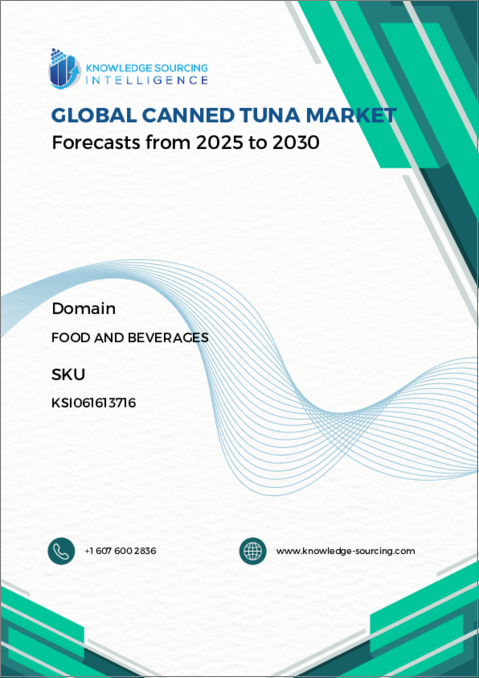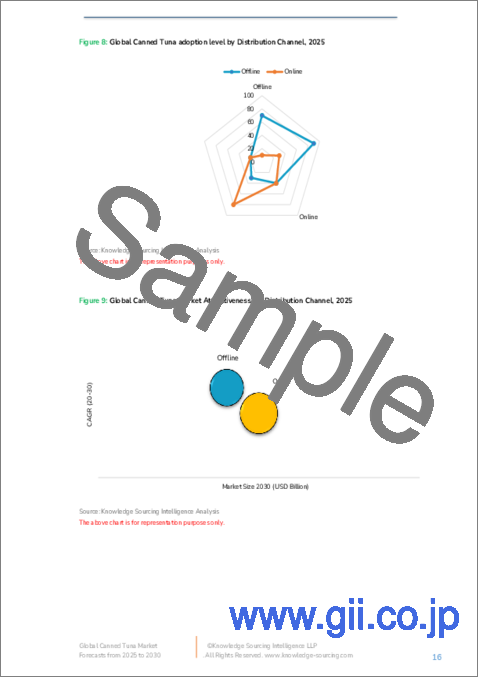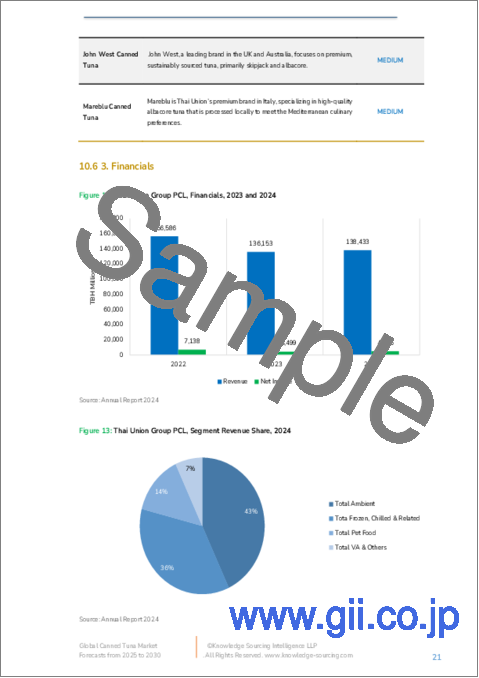|
|
市場調査レポート
商品コード
1479849
ツナ缶の世界市場-2024年から2029年までの予測Global Canned Tuna Market - Forecasts from 2024 to 2029 |
||||||
カスタマイズ可能
|
|||||||
| ツナ缶の世界市場-2024年から2029年までの予測 |
|
出版日: 2024年03月18日
発行: Knowledge Sourcing Intelligence
ページ情報: 英文 145 Pages
納期: 即日から翌営業日
|
全表示
- 概要
- 目次
ツナ缶の世界市場はCAGR3.78%で上昇し、2022年の102億2,900万米ドルから2029年には132億6,400万米ドルの市場規模に達すると予測されています。
ツナ缶は密閉容器にマグロを封入して保存性を確保します。この方法によって魚の賞味期限が延び、消費者の保存や使用に便利になります。中身は加熱処理されて細菌が死滅し、長期保存が可能になります。ツナ缶はさまざまな料理に使われる万能で便利な食品です。魚介類の消費動向の高まりが魚介類加工品の需要を押し上げ、ツナ缶の需要にプラスの影響を与えています。
例えば、「海洋管理協議会マグロハンドブック2022」によると、2021/2022年のMSC認証マグロ漁業数と漁獲量は、2021年9月の198万2,000トンから2022年9月には246万トンと大幅に増加しました。これはマグロ漁獲量が24%増加したことを意味します。2022年9月以降、19のマグロ漁業がMSC認証を取得し、合計91漁業となった。さらに報告書によると、世界のマグロ漁獲量の47%がMSC認証を取得しており(91の認証マグロ漁業)、世界のマグロ漁獲量の11%が現在MSC規格の審査中であり(36漁業が審査中)、世界のマグロ漁獲量の31%が現在FIP(基本的または包括的)であり、残りの11%はMSC認証も審査中もFIPでもないです。
さらに、ツナ缶を含む水産物缶詰は、その独特の食感と味、低脂肪、低カロリー、オメガ3必須脂肪酸の高い含有量により人気を集めています。市場の成長は、ツナ缶の新製品発売やサプライチェーン改善のための新政策によって牽引されると予想されます。
例えば、2023年6月、マグロサプライチェーンの透明性とデータ収集を強化するため、ウォルマートとサムズクラブは、ウォルマート米国、ウォルマートカナダ、サムズクラブのサプライヤーを対象とし、2027年までに100%オブザーバー監視のある漁船からのみ調達すること、100%オブザーバー監視の対象でない限り、公海積み替えゼロの漁業から調達することを義務付ける厳しいガイドラインを実施しました。世界の漁業の3分の1以上は、違法漁業や破壊的漁業のような制度的問題により、持続不可能なレベルで操業しています。
総合的にみると、ツナ缶は水産業界において重要なセグメントであり、その利便性、汎用性、たんぱく源としての人気によって牽引されています。手頃な価格、保存のしやすさ、手早く調理できることなどが需要の原動力となっています。同市場では、ライトやホワイトなど、さまざまな種類のツナ缶を提供しており、水、油、塩水で加工できるため、消費者の味の好みや食生活への配慮に応えることができます。同市場は世界中の家庭で主食となっています。
調理済み食品に対する消費者需要の高まりが市場拡大を後押し
調理済み食品や調理後すぐに食べられる食品は、その簡便性と利便性から人気が高まっています。ミレニアル世代は、調理時間の短さ、栄養価の高さ、使い勝手の良さなどから、これらの商品に惹かれています。食品業界は、消費者のライフスタイル、嗜好、市場力学の変化によって成長すると予想されます。時間的制約、家族力学の変化、都市化、多様性、選択肢が、こうしたコンビニエンス・フードの市場成長に寄与している主な要因です。多忙なライフスタイルと多忙なスケジュールにより、消費者は食事の準備に費やす時間が限られているため、こうした製品を手早く便利に使うことができます。また、あらかじめ計量された材料や簡単な調理手順など、利便性と使いやすさも提供されています。
共働き世帯や単身世帯など、進化する家族形態も、便利な食品オプションの需要に貢献しています。都市化によって居住スペースが狭くなり、台所設備も限られているため、こうした食品は都市部の消費者に適しています。国立水産研究所によれば、マグロ消費者の約45%が夕食に缶詰やパウチ入りのマグロを選んでいます。ツナ缶の52%はサンドイッチに、22%はサラダに、15.5%はキャセロールやヘルパーに、7.5%はベース料理に利用されています。18歳未満の子どもがいる家庭では、ツナサンドイッチを食べる確率が2倍高いです。
こうしたコンビニエンス・フードの市場は、さまざまな料理や味付けに広がり、利便性を犠牲にすることなく多様性を提供しています。食品技術の先進は、革新的なパッケージング、保存技術、原材料の配合により、こうした製品の品質と保存性を向上させてきました。健康とウェルネスへの配慮から、業界はより健康的な選択肢を提供するようになり、各社は天然素材、有機素材、栄養バランスのとれた素材を提供しています。
さらに、食品医薬品局はツナ缶の充填容器の識別と規格の改正案を提出しました。この規則案は、包装媒体が任意であることを明記し、安全で適切な香料や香辛料を任意添加物として使用できるようにし、計量手順を更新するものです。この規則案は、Bumble Bee Foods社、StarKist Co.社、Tri-Union Seafoods社から提出された市民請願に応えるものです。FDAは、より健康的な食品を生産するための革新のための業界の柔軟性を許容しながら、製品の基本的な性質と栄養の完全性を維持するために食品基準を近代化することを目指しています。
ロシア・ウクライナ戦争の影響分析
地政学的緊張に起因する貿易制限や関税は、紛争に見舞われた国々では価格の上昇、貿易量の減少、市場力学の変化が見られるため、ツナ缶市場に悪影響を及ぼす可能性があります。価格の変動は、貿易力学の変化、経費の増加、サプライチェーンの混乱によって引き起こされます。地政学的な出来事も国際関係や貿易協定に影響を与える可能性があり、マグロ缶詰業界に間接的な影響を与える可能性があります。ロシア主導のウクライナ紛争により、ベトナムのロシア向けパンガシウスとマグロの輸出が停止しています。ウクライナ侵攻後にロシアに課された国際制裁により、ロシアの銀行はSWIFT決済システムの使用を禁止され、両国間の貿易が複雑化しています。ロシアの輸入業者の中には、第三国に銀行口座を持っているところもあるが、手間がかかるうえに封鎖される危険性もあります。ロシア・ルーブルの価値の下落により、多くのロシアの輸入業者は貨物の全価値を支払う意思がないか、支払うことができないです。2021年末までに、ロシアとウクライナはベトナム産マグロ輸入国のトップ20のうちの2カ国となり、ベトナムから多くの冷凍マグロを輸入しています。
主要企業
- A.E.C Canning Co.
- Bumble Bee Foods LLCは、ツナスクランブルやツナキャセロールノックラザニアなど、さまざまな料理に使える高品質のツナ缶製品を提供することを重視しています。
目次
第1章 イントロダクション
- 市場概要
- 市場の定義
- 調査範囲
- 市場セグメンテーション
- 通貨
- 前提条件
- 基準年と予測年のタイムライン
- 利害関係者にとっての主なメリット
第2章 調査手法
- 調査デザイン
- 調査プロセス
第3章 エグゼクティブサマリー
- 主な調査結果
- アナリストビュー
第4章 市場力学
- 市場促進要因
- 市場抑制要因
- ポーターのファイブフォース分析
- 業界バリューチェーン分析
- アナリストビュー
第5章 ツナ缶の世界市場:種別
- イントロダクション
- カツオ
- 市場動向と機会
- 成長の見通し
- 地理的な利益性
- キハダマグロ
- 市場動向と機会
- 成長の見通し
- 地理的な利益性
- メバチマグロ
- 市場動向と機会
- 成長の見通し
- 地理的な利益性
- ビンナガマグロ
- 市場動向と機会
- 成長の見通し
- 地理的な利益性
- その他
- 市場動向と機会
- 成長の見通し
- 地理的な利益性
第6章 ツナ缶の世界市場:流通チャネル別
- イントロダクション
- オンライン
- 市場動向と機会
- 成長の見通し
- 地理的な利益性
- オフライン
- 市場動向と機会
- 成長の見通し
- 地理的な利益性
- ハイパーマーケットとスーパーマーケット
- 専門店
- その他
第7章 ツナ缶の世界市場:地域別
- イントロダクション
- 北米
- 種別
- 流通チャネル別
- 国別
- 南米
- 種別
- 流通チャネル別
- 国別
- 欧州
- 種別
- 流通チャネル別
- 国別
- 中東・アフリカ
- 種別
- 流通チャネル別
- 国別
- アジア太平洋
- 種別
- 流通チャネル別
- 国別
第8章 競合環境と分析
- 主要企業と戦略分析
- 市場シェア分析
- 合併、買収、合意およびコラボレーション
- 競合ダッシュボード
第9章 企業プロファイル
- A.E.C. Canning Co., Ltd.
- American Tuna
- Bumble Bee Foods LLC(FCF Co, Ltd.)
- Thunnus Overseas Group
- Golden Prize Canning Co., Ltd.
- Thai Union Group PCL
- Grupo Calvo
- Wild Planet Foods Inc.
- Frinsa del Noroeste S.A.
- PT. Aneka Tuna Indonesia
The global canned tuna market is projected to rise at a compound annual growth rate (CAGR) of 3.78% to reach a market valuation of US$13.264 billion by 2029, from US$10.229 billion in 2022.
Canned tuna involves sealing tuna in an airtight container to ensure preservation. This method extends the shelf life of the fish and makes it convenient for consumers to store and use. The contents are heat-processed to kill bacteria and ensure long-term preservation. Canned tuna is a versatile and convenient food product used in various dishes. The growing trend of seafood consumption and bolstered the demand for processed seafood items which has positively impacted the demand for canned tuna.
For instance, as per the "Marine Stewardship Council Tuna Handbook 2022", in 2021/ 2022, the number of MSC-certified tuna fisheries and catch volume increased significantly from 1,982,000 tonnes in September 2021 to 2,460,000 tonnes in September 2022. This signifies a 24% increase in tuna catch volume. From September 2022, 19 tuna fisheries achieved MSC certification, bringing the total to 91. The report further showed that 47% of global tuna catch were MSC certified (91 certified tuna fisheries), 11% of global tuna catch is currently in assessment to the MSC Standard (36 tuna fisheries in assessment) and 31% of global tuna catch is currently in a FIP (basic or comprehensive) and rest 11% are of global tuna catch is neither MSC certified, in assessment or a FIP.
Furthermore, canned seafood, including canned tuna, is gaining popularity due to its unique texture and taste, low fat, low calories, and high content of omega-3 essential fatty acids. The market growth is expected to be driven by the launch of new canned tuna products and new policies to improve the supply chain.
For instance, in June 2023, to enhance transparency and data collection in the tuna supply chain, Walmart and Sam's Club implemented stricter guidelines that cover Walmart U.S., Walmart Canada, and Sam's Club suppliers and require them to source exclusively from vessels with 100% observer monitoring by 2027 and from fisheries using zero high seas transshipment unless covered by 100% observer monitoring. Over one-third of the world's fisheries are operating at unsustainable levels due to systemic issues like illegal and destructive fishing.
Comprehensively, canned tuna is a significant segment in the seafood industry, driven by its convenience, versatility, and popularity as a protein source. Demand is driven by affordability, easy storage, and quick preparation. The market offers various varieties of canned tuna, including light and white options, and can be processed in water, oil, or brine, catering to consumers' taste preferences and dietary considerations. The market is a staple in households worldwide.
Rising consumer demand for ready-to-eat food has bolstered the market expansion
Ready-to-cook and ready-to-eat food products are increasingly popular due to their simplicity and convenience. The millennial generation is drawn to these items due to their low preparation time, high nutritional content, and ease of use. The food industry is expected to grow due to changing consumer lifestyles, preferences, and market dynamics. Time constraints, changing family dynamics, urbanization, variety, and options are key factors contributing to the market growth of these convenience foods. Busy lifestyles and hectic schedules leave consumers with limited time for meal preparation, making these products quick and convenient. They also offer convenience and ease of use, with pre-measured ingredients and simple cooking instructions.
Evolving family aspects, such as dual-income and single-person households, also contribute to the demand for convenient food options. Urbanization, with smaller living spaces and limited kitchen facilities, makes these foods well-suited for urban consumers. As per the National Fisheries Institute, around 45% of tuna consumers opt for canned or pouched tuna for dinner. 52% of canned tuna is utilized in sandwiches, 22% in salads, 15.5% in casseroles and helpers, and 7.5% in base dishes. Families with children under 18 are twice as likely to have tuna sandwiches.
The market for these convenience foods has expanded to include a wide range of cuisines and flavors, offering a variety without sacrificing convenience. Advancements in food technology have improved the quality and shelf life of these products, with innovative packaging, preservation techniques, and ingredient formulations. Health and wellness considerations have led to the industry offering healthier options, with companies offering natural, organic, and nutritionally balanced ingredients.
Additionally, the Food and Drug Administration put forward a proposal to amend the tuna can filling container identification and standard. The proposed rule would specify that a packing medium is optional, enable safe and appropriate flavorings and spices as optional additives, and update weighing procedures. The proposed rule is in response to a citizen petition submitted by Bumble Bee Foods, StarKist Co., and Tri-Union Seafoods. The FDA aims to modernize food standards to maintain the basic nature and nutritional integrity of products while allowing industry flexibility for innovation to produce more healthful foods.
Russia Ukraine War Impact Analysis
Trade restrictions and tariffs resulting from geopolitical tensions can harm the canned tuna market as conflict-ridden nations may see higher prices, lower trade volumes, and altered market dynamics. Price swings can be caused by changes in the trade dynamics, higher expenses, or disruptions in the supply chain. Geopolitical events can also have an impact on international relations and trade agreements, which could have an indirect effect on the canned tuna industry. Vietnam's pangasius and tuna exports to Russia have been halted because of the Russian-led conflict in Ukraine. International sanctions imposed on Russia following Ukraine's invasion have complicated trade between the two countries, with Russian banks banned from using the SWIFT payment system. Some Russian importers have functioning bank accounts in third countries, but these are time-consuming and at risk of being blocked. The decline in the value of the Russian ruble has made many Russian importers unwilling or unable to pay the full value for cargo. By the end of 2021, Russia and Ukraine will be two of the 20 largest importers of Vietnamese tuna by value, importing a lot of frozen tuna from Vietnam.
Key Players:
- A.E.C Canning Co. Ltd visualizes itself to be a reliable seafood manufacturer inclusive of tuna and sardines on a global scale .
- American Tun aims to bring sustainably sourced seafood that supports US fishing communities.
- Bumble Bee Foods LLC emphasizes providing high-quality canned tuna products that could be used in different cuisine such as tuna scramble and tuna casserole knock lasagna.
Segmentation:
By Species
- Skipjack
- Yellowfin
- Bigeye
- Albacore
- Others
By Distribution Channel:
- Online
- Offline
- Hypermarkets & Supermarkets
- Specialty Stores
- Others
By Geography
- North America
- USA
- Canada
- Mexico
- South America
- Brazil
- Argentina
- Others
- Europe
- UK
- Germany
- France
- Italy
- Others
- Middle East and Africa
- Saudi Arabia
- UAE
- Others
- Asia Pacific
- China
- Japan
- India
- South Korea
- Taiwan
- Thailand
- Indonesia
- Others
TABLE OF CONTENTS
1. INTRODUCTION
- 1.1. Market Overview
- 1.2. Market Definition
- 1.3. Scope of the Study
- 1.4. Market Segmentation
- 1.5. Currency
- 1.6. Assumptions
- 1.7. Base, and Forecast Years Timeline
- 1.8. Key Benefits for the Stakeholders
2. RESEARCH METHODOLOGY
- 2.1. Research Design
- 2.2. Research Process
3. EXECUTIVE SUMMARY
- 3.1. Key Findings
- 3.2. Analyst view
4. MARKET DYNAMICS
- 4.1. Market Drivers
- 4.2. Market Restraints
- 4.3. Porter's Five Forces Analysis
- 4.3.1. Bargaining Power of Suppliers
- 4.3.2. Bargaining Power of Buyers
- 4.3.3. Threat of New Entrants
- 4.3.4. Threat of Substitutes
- 4.3.5. Competitive Rivalry in the Industry
- 4.4. Industry Value Chain Analysis
- 4.5. Analyst View
5. GLOBAL CANNED TUNA MARKET BY SPECIES
- 5.1. Introduction
- 5.2. Skipjack
- 5.2.1. Market Trends and Opportunities
- 5.2.2. Growth Prospects
- 5.2.3. Geographic Lucrativeness
- 5.3. Yellowfin
- 5.3.1. Market Trends and Opportunities
- 5.3.2. Growth Prospects
- 5.3.3. Geographic Lucrativeness
- 5.4. Bigeye
- 5.4.1. Market Trends and Opportunities
- 5.4.2. Growth Prospects
- 5.4.3. Geographic Lucrativeness
- 5.5. Albacore
- 5.5.1. Market Trends and Opportunities
- 5.5.2. Growth Prospects
- 5.5.3. Geographic Lucrativeness
- 5.6. Others
- 5.6.1. Market Trends and Opportunities
- 5.6.2. Growth Prospects
- 5.6.3. Geographic Lucrativeness
6. GLOBAL CANNED TUNA MARKET BY DISTRIBUTION CHANNEL
- 6.1. Introduction
- 6.2. Online
- 6.2.1. Market Trends and Opportunities
- 6.2.2. Growth Prospects
- 6.2.3. Geographic Lucrativeness
- 6.3. Offline
- 6.3.1. Market Trends and Opportunities
- 6.3.2. Growth Prospects
- 6.3.3. Geographic Lucrativeness
- 6.3.4. Hypermarkets & Supermarkets
- 6.3.5. Specialty Stores
- 6.3.6. Others
7. GLOBAL CANNED TUNA MARKET BY GEOGRAPHY
- 7.1. Introduction
- 7.2. North America
- 7.2.1. By Species
- 7.2.2. By Distribution Channel
- 7.2.3. By Country
- 7.2.3.1. USA
- 7.2.3.1.1. Market Trends and Opportunities
- 7.2.3.1.2. Growth Prospects
- 7.2.3.2. Canada
- 7.2.3.2.1. Market Trends and Opportunities
- 7.2.3.2.2. Growth Prospects
- 7.2.3.3. Mexico
- 7.2.3.3.1. Market Trends and Opportunities
- 7.2.3.3.2. Growth Prospects
- 7.2.3.1. USA
- 7.3. South America
- 7.3.1. By Species
- 7.3.2. By Distribution Channel
- 7.3.3. By Country
- 7.3.3.1. Brazil
- 7.3.3.1.1. Market Trends and Opportunities
- 7.3.3.1.2. Growth Prospects
- 7.3.3.2. Argentina
- 7.3.3.2.1. Market Trends and Opportunities
- 7.3.3.2.2. Growth Prospects
- 7.3.3.3. Others
- 7.3.3.3.1. Market Trends and Opportunities
- 7.3.3.3.2. Growth Prospects
- 7.3.3.1. Brazil
- 7.4. Europe
- 7.4.1. By Species
- 7.4.2. By Distribution Channel
- 7.4.3. By Country
- 7.4.3.1. United Kingdom
- 7.4.3.1.1. Market Trends and Opportunities
- 7.4.3.1.2. Growth Prospects
- 7.4.3.2. Germany
- 7.4.3.2.1. Market Trends and Opportunities
- 7.4.3.2.2. Growth Prospects
- 7.4.3.3. France
- 7.4.3.3.1. Market Trends and Opportunities
- 7.4.3.3.2. Growth Prospects
- 7.4.3.4. Spain
- 7.4.3.4.1. Market Trends and Opportunities
- 7.4.3.4.2. Growth Prospects
- 7.4.3.5. Italy
- 7.4.3.5.1. Market Trends and Opportunities
- 7.4.3.5.2. Growth Prospects
- 7.4.3.6. Others
- 7.4.3.6.1. Market Trends and Opportunities
- 7.4.3.6.2. Growth Prospects
- 7.4.3.1. United Kingdom
- 7.5. Middle East and Africa
- 7.5.1. By Species
- 7.5.2. By Distribution Channel
- 7.5.3. By Country
- 7.5.3.1. UAE
- 7.5.3.1.1. Market Trends and Opportunities
- 7.5.3.1.2. Growth Prospects
- 7.5.3.2. Israel
- 7.5.3.2.1. Market Trends and Opportunities
- 7.5.3.2.2. Growth Prospects
- 7.5.3.3. Saudi Arabia
- 7.5.3.3.1. Market Trends and Opportunities
- 7.5.3.3.2. Growth Prospects
- 7.5.3.4. Others
- 7.5.3.4.1. Market Trends and Opportunities
- 7.5.3.4.2. Growth Prospects
- 7.5.3.1. UAE
- 7.6. Asia Pacific
- 7.6.1. By Species
- 7.6.2. By Distribution Channel
- 7.6.3. By Country
- 7.6.3.1. Japan
- 7.6.3.1.1. Market Trends and Opportunities
- 7.6.3.1.2. Growth Prospects
- 7.6.3.2. China
- 7.6.3.2.1. Market Trends and Opportunities
- 7.6.3.2.2. Growth Prospects
- 7.6.3.3. India
- 7.6.3.3.1. Market Trends and Opportunities
- 7.6.3.3.2. Growth Prospects
- 7.6.3.4. South Korea
- 7.6.3.4.1. Market Trends and Opportunities
- 7.6.3.4.2. Growth Prospects
- 7.6.3.5. Indonesia
- 7.6.3.5.1. Market Trends and Opportunities
- 7.6.3.5.2. Growth Prospects
- 7.6.3.6. Taiwan
- 7.6.3.6.1. Market Trends and Opportunities
- 7.6.3.6.2. Growth Prospects
- 7.6.3.7. Others
- 7.6.3.7.1. Market Trends and Opportunities
- 7.6.3.7.2. Growth Prospects
- 7.6.3.1. Japan
8. COMPETITIVE ENVIRONMENT AND ANALYSIS
- 8.1. Major Players and Strategy Analysis
- 8.2. Market Share Analysis
- 8.3. Mergers, Acquisition, Agreements, and Collaborations
- 8.4. Competitive Dashboard
9. COMPANY PROFILES
- 9.1. A.E.C. Canning Co., Ltd.
- 9.2. American Tuna
- 9.3. Bumble Bee Foods LLC (FCF Co, Ltd.)
- 9.4. Thunnus Overseas Group
- 9.5. Golden Prize Canning Co., Ltd.
- 9.6. Thai Union Group PCL
- 9.7. Grupo Calvo
- 9.8. Wild Planet Foods Inc.
- 9.9. Frinsa del Noroeste S.A.
- 9.10. PT. Aneka Tuna Indonesia





